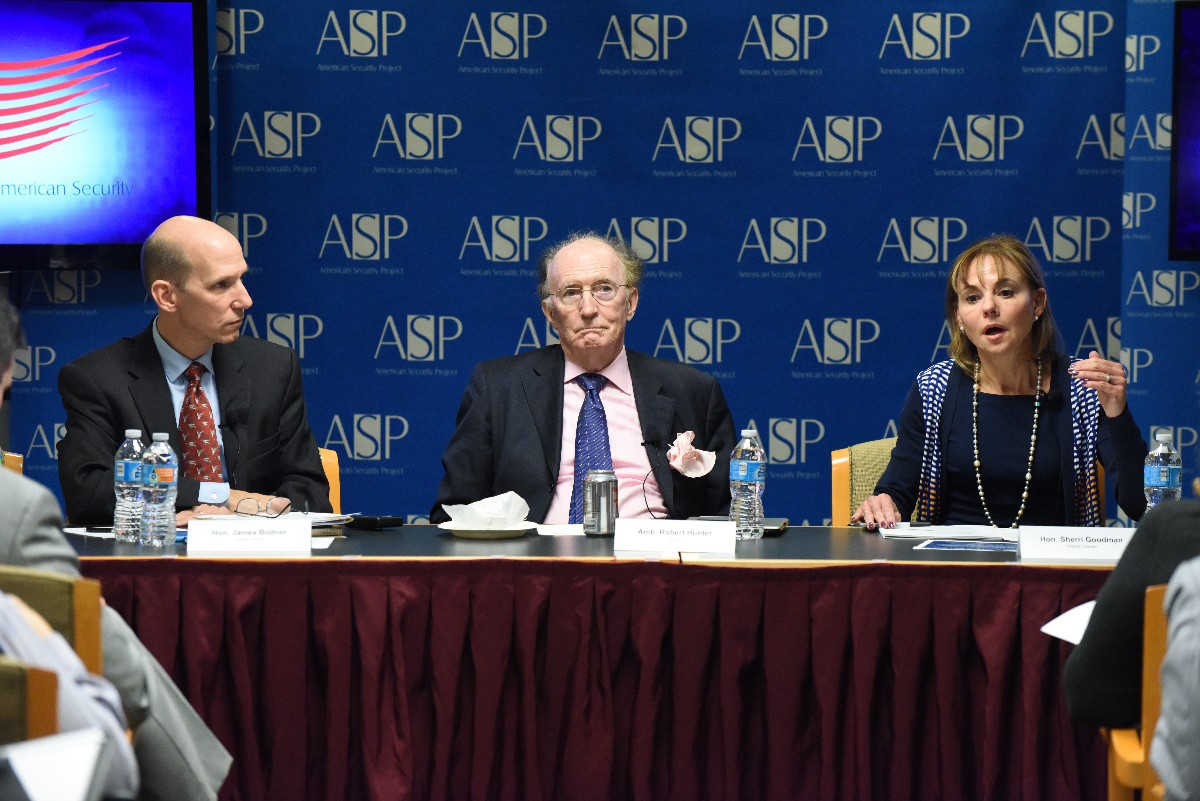
Event Recap: Assessing the drivers of U.S. Arctic policy
On November 1, the American Security Project hosted a panel to discuss the recently released International Security Advisory Board (ISAB) report on U.S. Arctic policy. The panel, titled, “The Arctic: Assessing the geopolitical, economic, military, and environmental drivers of U.S. Arctic policy,” was joined by three of the reports drafters, ASP CEO and panel moderator Brg. Gen. Cheney, Hon. Sherri Goodman, and Amb. Robert Hunter, along with Hon. James Bodner. Their discussion covered both the recommendations of the report and offered insight into the competing geopolitical interests that underscore U.S. Arctic policy.
The Arctic is an area of interest for countries across the globe and the rapid changes the region is experiencing, alongside the region’s competing geopolitical interests, present a series of challenges and opportunities for the United States. Ms. Goodman neatly summarized the region’s key destabilizing forces and the areas where the U.S. is making headway. Her points that there are both destabilizing and stabilizing forces are as follows:
- Climate change is causing ocean temperatures to rise, permafrost to disappear, ice melt to increase, and climate refugees to abandon villages.
- Russia and the U.S. cooperate in the Arctic, but worsening relations over the issues of Ukraine and Syria and the resource create concern.
- China’s resource expansionary goals are a source of concern.
- The increase in governance and U.S. leadership in the Arctic Council has been broad across the different arenas of Arctic operations. The U.S. Coast Guard in particular has been extremely effective in reacting to region’s immediate risks, primarily oil spills and search and rescue missions, and their efforts have put them in direct cooperation with the Russian military.
- The U.S. Government has become more organized, coordinating both public and private efforts.
- The emerging field of science diplomacy, reflected in events like the White House Arctic Science Ministerial, coordinates scientists from around the world and across cultures to share successes in fishing, energy, climate change research, and relevant technological advances.
Participants note that global focus on the Arctic was partially driven by its energy resources. The low prices of oil have thrown commercial interests, but energy resources remain an underlying motivator of state interests and underscore the need for geopolitical balance.
A primary motivator for the ISAB report’s mandate was to explore Russian interests in the region, and while opinions on the Russian issue were generally optimistic, the panel’s views were varied. Ambassador Hunter, previously the U.S. Ambassador to NATO, was less optimistic on the Russian issue, and attributed nuclear ambitions as a driver for Russian Arctic policy, since a large fraction of Russia’s nuclear deterrent operates in the region. This must also inform U.S. policy towards the Arctic, and Amb. Hunter sees U.S. leadership and predictability in the region as critical to assure allies and limit the Russian threat.
For Mr. Bodner, vastly different interests between the leading nations in the region, such as Canada, Russia, China, and the U.S., present a set of challenges that complicate U.S. leadership goals. However, communication and bilateral efforts to create uniform climate regulation would help in negating these challenges. Bodner also stressed the importance of maximizing the utility of every dollar directed towards the Arctic, and this is a goal that must be met with heightened coordination between state and commercial interests.
The panel’s discussion broadly outlined how the six recommendations in the report, listed below, were reached.
- The U.S. must continue its pattern of leadership beyond its position as Chair of the Arctic Council.
- The U.S. must ratify the United Nations Convention on the Law of the Sea (UNCLOS), which is pivotal for the U.S. to legitimize its Arctic interests.
- The U.S. must increase presence and domain awareness in the Arctic region, which is changing rapidly. This also includes investing in infrastructure, particularly for the development of additional icebreakers, which are severely lacking.
- The U.S. must increase cooperation with the multiple states that claim interests in the Arctic, a region where state and commercial interests unite countries across the globe.
- The U.S. must work to better understand Russian capabilities in the Arctic to avoid miscalculations that can lead to escalation. S.-Russian Arctic operations are a source of optimism between the two nations, and this must be continued.
- The U.S. must strengthen transparency and confidence building measures to protect U.S. interests and relationships in the region.
The U.S. will, in a matter of months, have a new administration, and then only months after that, will hand over Chairmanship of the Arctic Council to Finland. All panel members were in agreement that the U.S. Arctic policy is one that requires urgency and attention. If the progress represented in this ISAB report is allowed to atrophy, the consequences on U.S. influence in the region could suffer dramatically and the balance of power will shift in a direction that does not benefit U.S. interests.
The audio of the event can be found below.
Further Reading
- Download and read the whole ISAB report here
- AEC Summary – Former Senior Defense & State Department Officials See Opportunity for U.S. Leadership in the Arctic
- ASP Report – America’s Role in the Arctic: Opportunity and Security in the High North
- ASP Congressional Testimony: “The United States as an Arctic Nation: Opportunities in the High North”
Images of the event can be found by following the icon below.
This event was sponsored by the Arctic Energy Center.







